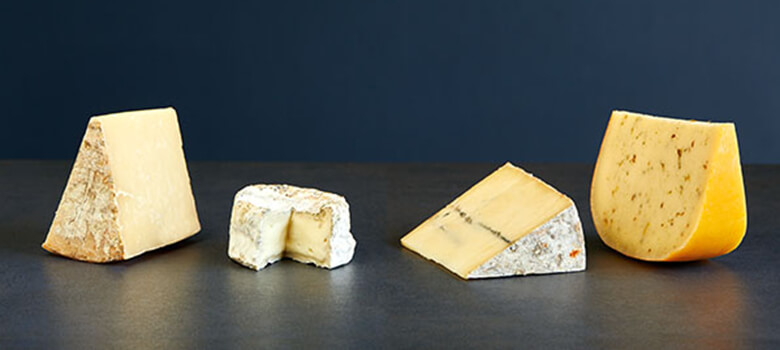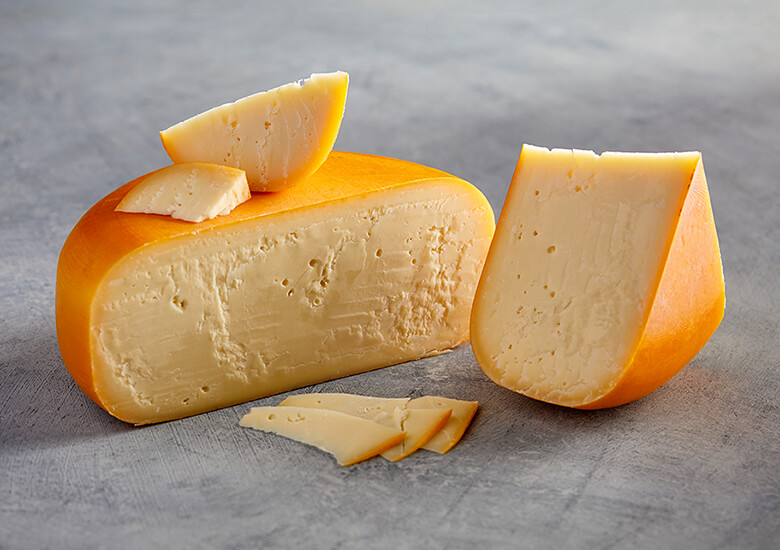All About Rinds
If you love cheese as much as we do, you’ll want to take in the full sensory experience that every cheese has to offer. For most cheeses, the rind is a key part of that. You can think of a cheese rind as the protective blanket surrounding the outside of your cheese, but keep in mind that's not the only purpose it serves.
The rind isn't just there to protect cheese from the elements: it can impart its own unique flavor and texture to your cheese.
Rinds You Should Eat

Flavored rind
Flavored rinds are lovingly created by soaking or rubbing the outside of the cheese with another ingredient like beer, wine, fresh black pepper, or even espresso. We already know that wine and cheese is a match made in heaven, but what if you rubbed the outside of an aged cheddar with green chartreuse? Answer: a glorious flavored rind! These rinds are expertly crafted to complement whatever cheese they enshrine, creating a whole new cheese experience. Do yourself a favor and try them out. Your taste buds will thank you.
Washed rind
A “washed rind” describes any cheese that was treated with a brine rinse. During the aging process, many cheeses are gently bathed in a saltwater wash that often includes added cultures.
This technique helps bring out the natural savory flavors of the cheese and introduces funky aromas on the naturally occurring rind that gently diffuse into the bordering cheese paste.
Pungent, stinky cheeses like limburger fall into this category. Scared of the stink? Don’t be! These bold flavors will blow you away.
Bloomy rind
Also known as soft-ripened cheese, this type of rind refers to cheeses that are ripened from the outside and whose rinds are made from a perfect amalgamation of mold and yeast. Bloomy rinds create a flavorful, textured, and very edible crust, which encourages the cheese inside to ripen. It’s what gives soft-ripened cheeses like brie their lusciously creamy texture. Basically, it’s the best thing ever.
Rinds You Can Skip

Bandaged-wrapped rind
Don’t call the doctor - your cheese isn’t injured! This rind is made from cloth, allowing your cheese to breathe during aging and giving your cheese a drier, more crumbly texture. A bandage-wrapped rind, like the ones found on some varieties of aged cheddar, contributes to the complex flavor and dense, flakey texture of these cheeses. This type of rind is not edible and should be removed before enjoying the cheese.
Wax rind
If cheese is the gift and wax rind is the inedible wrapping paper, you should take the wrapping paper off just as you would with any gift. Semi-firm cheeses like gouda are often dipped into a wax that seals the cheese into a safe home while it ages. This type of rind helps maintain moisture in the cheese, so nothing gets in or out. While technically food safe (but still quite inedible), we’d advise removing a wax rind before digging into whatever cheese you’re planning on enjoying.
Natural rind
Our final stop on this journey of rinds is the natural rind. Organically formed on cheeses like parmesan, a natural rind forms on cheese that is aged in a temperature and humidity-controlled room also often known as a cave. As time goes on, the rind dries out and forms a hard, outer layer.
These flavorful rinds are perfectly edible, but sadly too hard to enjoy on their own. However, they’re the perfect candidate for use when cooking soups or broths. Make sure you hold onto them!
Go forth and explore!
Now that you’ve successfully traversed the world of cheese rinds, you’ll be ready to handle any kind of rind you encounter. If you’re looking for some appetizing recipes that make use of those rinds, try out this Asiago White Turkey Chili or this Autumn Tuscan Bread Soup. Or, pick something else that suits your style from our selection of over 300 handcrafted recipes featuring Wisconsin cheese. Share your creation with us on Instagram or Facebook and become part of the largest cheese community in the world.
FAQs: Cheese Rinds
Is it safe to eat cheese rinds?
In a word: yes. Cheese rinds are food safe and edible. However, only some are meant to be eaten. You should feel free to enjoy flavored rinds, washed rinds, and bloomy rinds as part of your cheese eating experience. Other rinds made of wax or cloth can generally be removed and discarded—these rinds are there to protect the cheese along its aging journey. Finally, natural rinds on cheeses like parmesan are ideal for use in cooking or broths—just not eating on their own. (They’re just a bit too hard.)
Can I eat the wax on cheese?
We appreciate the enthusiasm but unfortunately, the wax isn’t meant to be eaten. The gift of cheese is best enjoyed unwrapped and free of wax. Don’t sweat it if you ate some though. It’s 100% food safe.
What is the rind of cheese made of?
Cheese rinds generally fall into two categories. The first category of rind can be thought of like a bread crust: delicious and a key part of the journey of texture you’re about to embark on (unless you’re one of those crazy people that cuts the crust off). The second category of rind is more like wrapping paper. It acts like a protective layer for the cheese during the aging process but is best removed when it’s time to enjoy.
Can I eat parmesan rind?
You could, but the texture would be rough on the palate. The rind is still filled with all the rich flavor of the cheese; it just needs a little extra love to extract it. Known as the bay leaves of cheese world, parmesan rinds can instantly elevate any sauce or soup. Try adding some parm’ rinds to your next pasta sauce. We promise you’ll be blown away.
